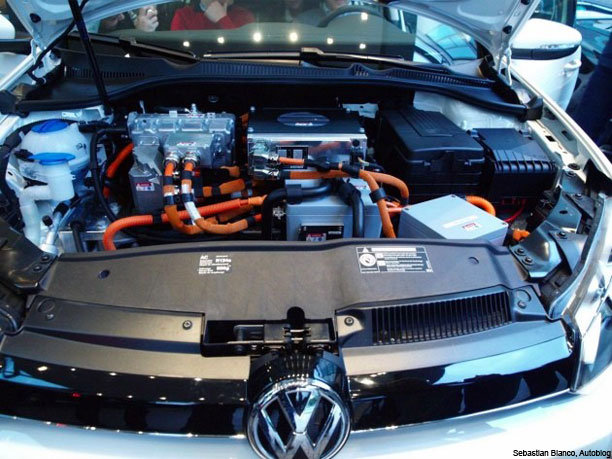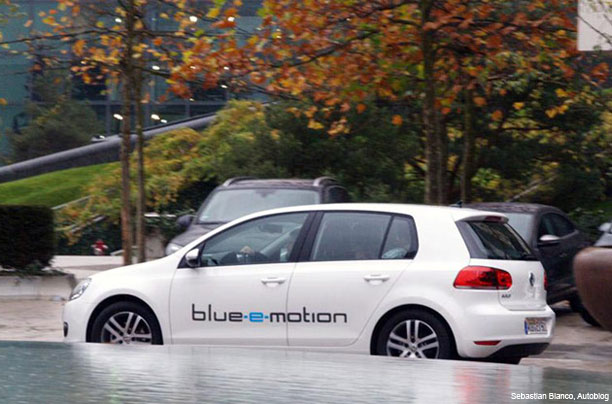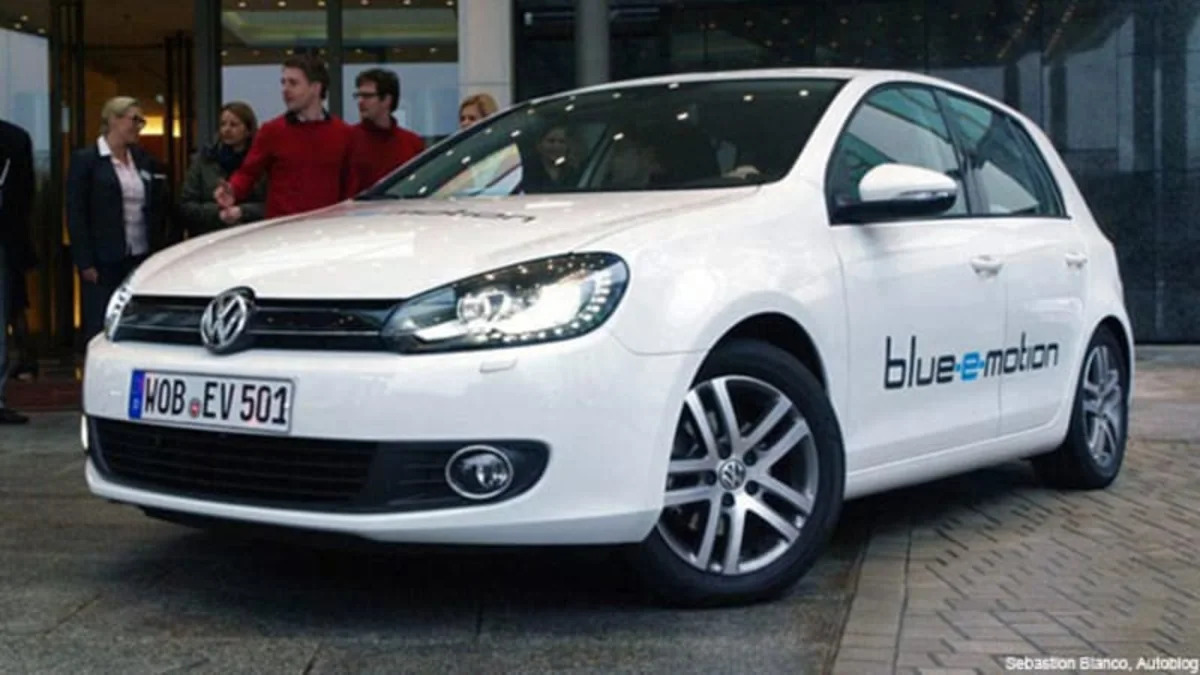Don't tell Volkswagen that it's behind the curve on electric vehicles. The company is showing off its brand new e Golf – sorry, Golf Blue-e-motion – to journalists in Wolfburg, Germany this week, and is making sure to remind us that it has made at least 20 plug-in or hybrid prototypes in the past four decades, from the Electric Transporter in 1973 to the Space Up! in 2007. Okay, the company may not bring an electric vehicle (EV) to market until 2013 – three years after Nissan and General Motors – but that doesn't mean VW is really behind its competition. This is the company line, anyway, and VW just might have a point. The press release announcing the latest on the electric Golf, for example, says that, while the prototype vehicle gets around 100 miles of range today, the version that will be released in 2014, "is expected to be significantly improved with the battery technology used then." That's a real advantage, no? This appears to be VW's game: make EVs at its own pace and try to get it right in a big way. We got a behind-the-wheel preview of 2014 with a short test drive of the Golf Blue-e-Motion and lots more on VW's e-mobility strategy.
Driving the Golf Blue-e-motion: wherein we discover just how bad this thing needs a new name
Early one morning we were given the keys to a Golf R, the performance version of VW's most popular vehicle, and rocked it up to 125 miles per hour on the Autobahn. Man, that's fun. The Golf Blue-e-motion can't quite match that, topping out at a max speed of just 135 km/h (about 84 miles per hour), but that doesn't mean the car isn't also a blast to pilot. Calling it a "blue emotion" is just wrong. The car isn't depressing in the least. The company line on EVs? That's a bit of a downer, but not the car.
The one thing VW got absolutely right: selectable regenerative braking. There are four levels, from sailing to harsh regen, and it's great to be able to use the shifter paddles on the steering wheel to cycle through them. We'd have been quite happy with the two settings at the extremes, but we won't quibble with four. Cruising through wet Wolfsburg streets with the Golf Blue-e-motion's weight split 50/50 thanks to the battery placement, which is quite different than the front-biased standard Golf, handling was great at city speeds. The e Golf is also incredibly quiet, even for an electric vehicle, and that's saying something. It doesn't hurt that the Golf on which it's based is already a quiet ride. One big problem: the accelerator pedal completely lost the ability to function on a highway exit ramp, but a few restarts solved the problem. Such is the life of a prototype vehicle.

Aside from the different regen levels, there are three drive modes to change how the car behaves: Normal, Comfort+ and Range+ (guess what they do), which are selectable on the go by a button near the shifter. Unlike the Nissan Leaf, which brilliantly adjusts the displayed "range to empty" figure as you play with the settings, the RTE number in the eGolf only adjusts to your current driving style, not the "range+" button. This means that, over the course of probably five kilometers of increasingly careful driving, we managed to keep the estimate at 70 km, even while the battery state of charge number kept dropping. Under normal driving conditions, it appears these numbers usually decrease in tandem, implying that the electric Golf has a real-world range closer to 60 miles than the 90+ quoted by VW. Without more time behind the wheel (we were given just 15 minutes), it's hard to know for sure, but we think VW's got room for improvement here.
There are other things that might change in the next four or so years. The car has no creep at idle, but it might based on the markets where the car is sold. Also, when the car is actually released, it will be based on the then-current Golf, not today's model, which is what we drove. We'd like to see the regen modes – currently called D, D1, D2 and D3 – given better names and or abilities, something like a "slow traffic" mode would be great. If VW could figure out how to make the car automatically adjust these braking levels based on things like GPS and traffic reports, that'd be pretty slick.

More details on the car: wherein we learn about the long path VW is taking
Speaking to the group of journalists at the end of a long and rainy day, Christian Klingler, VW Group board member of sales and marketing, repeated the mantra that VW has been working on electric cars for decades and is happy with its timetable. If this is true, then the obvious question is why is the company now ready to move from the R&D labs into the showroom? Klingler said it's because customers are more aware of the environmental impacts of everything today, and events like the Deepwater Horizon explosion have had a tremendous impact in the U.S. "We are sure electrification is the right path," he said.
Right now, there are only five or six Golf Blue-e-motions in the world, one of which just won the first Brighton to London Future Car Challenge in the UK this past weekend. As for the path to the eGolf's widespread availability, VW's Rudolf Kreps, group chief officer for electric traction, told AutoblogGreen that there has been no change in the timetable to bring the Golf Blue-e-motion to market (there was, though, as you can see in this press release).
So, with that in mind, here's the short version of VW's current electric vehicle plans: Jetta hybrid, which VW is trying to position as a performance hybrid, is coming in 2012. The company's first pure EV, the Up!, follows in Europe in 2013. In 2014, the electric Golf will make an appearance, followed by a plug-in hybrid of some sort. Prices, volume and release dates for these vehicles are all complete unknowns at this point, but Klingler said that the company will be flexible with production capacity numbers. This is one reason, he said, that it might be a good thing not to be first out of the EV gate. After all, the Honda Insight was the first hybrid to come to the U.S., but that's not the car that we automatically associate with the word "hybrid" today, is it? Just saying.

Even with all of this pro-EV talk, it's clear that there is still some serious EV skepticism at diesel-loving VW. Klingler said it most clearly:
The electric car is not a request from the customer. It's a request from the government. Developments are increasing the willingness of the customers to buy this car but it's important to understand that, from a market point of view, this is not so easy.
VW knows something about customer requests, because it is currently very big into conducting market research. The reason for all the queries is because VW has set four ambitious goals for itself for 2018:
In talking with customers and potential customers around the world, VW says it has a good idea of what it will take to reach those goals. For various reasons, company execs know they have to play the plug-in game, but no one thinks these are the cars that will lead the way. Klingler said that the question about estimating the market share of plug-in vehicles in 2018 is "one of the most complicated to answer." There are studies that say it'll be three to five percent, others that say there's no way it'll be more than three and others that say it'll be more than five. Klinger wouldn't say what he or VW expects, but did say that whatever the number is for the industry as a whole is what it'll be for VW. When you enter the market with the second-wave of modern plug-in vehicles, can you expect anything more than that?
Driving the Golf Blue-e-motion: wherein we discover just how bad this thing needs a new name
Early one morning we were given the keys to a Golf R, the performance version of VW's most popular vehicle, and rocked it up to 125 miles per hour on the Autobahn. Man, that's fun. The Golf Blue-e-motion can't quite match that, topping out at a max speed of just 135 km/h (about 84 miles per hour), but that doesn't mean the car isn't also a blast to pilot. Calling it a "blue emotion" is just wrong. The car isn't depressing in the least. The company line on EVs? That's a bit of a downer, but not the car.
The one thing VW got absolutely right: selectable regenerative braking. There are four levels, from sailing to harsh regen, and it's great to be able to use the shifter paddles on the steering wheel to cycle through them. We'd have been quite happy with the two settings at the extremes, but we won't quibble with four. Cruising through wet Wolfsburg streets with the Golf Blue-e-motion's weight split 50/50 thanks to the battery placement, which is quite different than the front-biased standard Golf, handling was great at city speeds. The e Golf is also incredibly quiet, even for an electric vehicle, and that's saying something. It doesn't hurt that the Golf on which it's based is already a quiet ride. One big problem: the accelerator pedal completely lost the ability to function on a highway exit ramp, but a few restarts solved the problem. Such is the life of a prototype vehicle.

Aside from the different regen levels, there are three drive modes to change how the car behaves: Normal, Comfort+ and Range+ (guess what they do), which are selectable on the go by a button near the shifter. Unlike the Nissan Leaf, which brilliantly adjusts the displayed "range to empty" figure as you play with the settings, the RTE number in the eGolf only adjusts to your current driving style, not the "range+" button. This means that, over the course of probably five kilometers of increasingly careful driving, we managed to keep the estimate at 70 km, even while the battery state of charge number kept dropping. Under normal driving conditions, it appears these numbers usually decrease in tandem, implying that the electric Golf has a real-world range closer to 60 miles than the 90+ quoted by VW. Without more time behind the wheel (we were given just 15 minutes), it's hard to know for sure, but we think VW's got room for improvement here.
There are other things that might change in the next four or so years. The car has no creep at idle, but it might based on the markets where the car is sold. Also, when the car is actually released, it will be based on the then-current Golf, not today's model, which is what we drove. We'd like to see the regen modes – currently called D, D1, D2 and D3 – given better names and or abilities, something like a "slow traffic" mode would be great. If VW could figure out how to make the car automatically adjust these braking levels based on things like GPS and traffic reports, that'd be pretty slick.

More details on the car: wherein we learn about the long path VW is taking
Speaking to the group of journalists at the end of a long and rainy day, Christian Klingler, VW Group board member of sales and marketing, repeated the mantra that VW has been working on electric cars for decades and is happy with its timetable. If this is true, then the obvious question is why is the company now ready to move from the R&D labs into the showroom? Klingler said it's because customers are more aware of the environmental impacts of everything today, and events like the Deepwater Horizon explosion have had a tremendous impact in the U.S. "We are sure electrification is the right path," he said.
Right now, there are only five or six Golf Blue-e-motions in the world, one of which just won the first Brighton to London Future Car Challenge in the UK this past weekend. As for the path to the eGolf's widespread availability, VW's Rudolf Kreps, group chief officer for electric traction, told AutoblogGreen that there has been no change in the timetable to bring the Golf Blue-e-motion to market (there was, though, as you can see in this press release).
So, with that in mind, here's the short version of VW's current electric vehicle plans: Jetta hybrid, which VW is trying to position as a performance hybrid, is coming in 2012. The company's first pure EV, the Up!, follows in Europe in 2013. In 2014, the electric Golf will make an appearance, followed by a plug-in hybrid of some sort. Prices, volume and release dates for these vehicles are all complete unknowns at this point, but Klingler said that the company will be flexible with production capacity numbers. This is one reason, he said, that it might be a good thing not to be first out of the EV gate. After all, the Honda Insight was the first hybrid to come to the U.S., but that's not the car that we automatically associate with the word "hybrid" today, is it? Just saying.

Even with all of this pro-EV talk, it's clear that there is still some serious EV skepticism at diesel-loving VW. Klingler said it most clearly:
The electric car is not a request from the customer. It's a request from the government. Developments are increasing the willingness of the customers to buy this car but it's important to understand that, from a market point of view, this is not so easy.
VW knows something about customer requests, because it is currently very big into conducting market research. The reason for all the queries is because VW has set four ambitious goals for itself for 2018:
- To be the market leader in customer satisfaction
- To have the best workers, and have them be the most satisfied, too
- To make money
- To sell 10 million cars a year, including a million in the U.S. (between the Audi and VW brands)
In talking with customers and potential customers around the world, VW says it has a good idea of what it will take to reach those goals. For various reasons, company execs know they have to play the plug-in game, but no one thinks these are the cars that will lead the way. Klingler said that the question about estimating the market share of plug-in vehicles in 2018 is "one of the most complicated to answer." There are studies that say it'll be three to five percent, others that say there's no way it'll be more than three and others that say it'll be more than five. Klinger wouldn't say what he or VW expects, but did say that whatever the number is for the industry as a whole is what it'll be for VW. When you enter the market with the second-wave of modern plug-in vehicles, can you expect anything more than that?


Sign in to post
Please sign in to leave a comment.
Continue